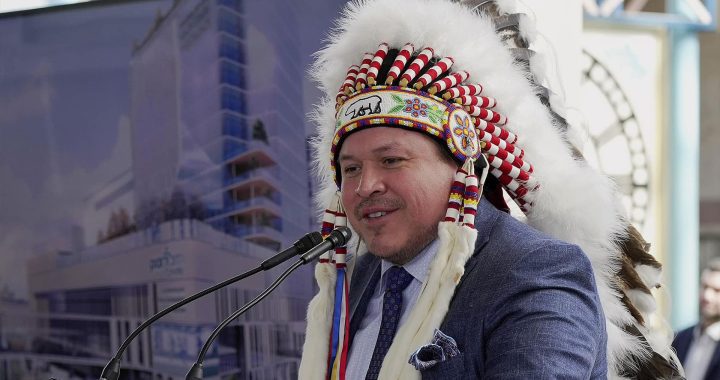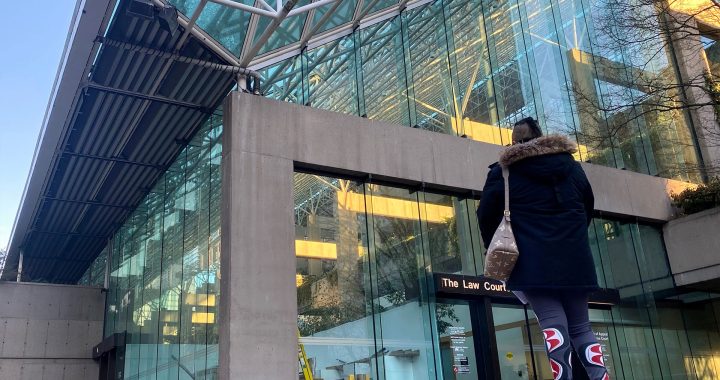Leo Bruno looks out across the calm waters of Battle River and quietly prays to Kakisimo, the Creator.
It’s a place his whole family would come to water their horses and collect berries, ancestral lands that hold great cultural and spiritual significance to the Cree of Treaty 6.
A connection to the past, that has been kept alive through the resilience of the people but was once nearly destroyed by the dark legacy of Canada’s residential school system.
Bruno’s cree name is Kisikawasis, given to him as a child in his home of Meseekopawk, Samson Cree Nation one of the four nations of Maskwacis in central Alberta, abut an hour’s drive south of Edmonton. The nation encompasses the communities of Louis Bull, Montana, Samson and Ermineskin.
It’s here in his traditional territory, at the site of the former Ermineskin Indian Residential School that Bruno anticipates Pope Francis’ apology for role the Roman Catholic church played in the residential school system.

The Ermineskin Cree Nation school operated from 1895 to 1975 and was one of the largest residential schools in the country.
Bruno was ripped from his family and forced to attend the facility when he was only six years old.
“I was sent to school the very first day of school in 1958, my very first day of school I got into trouble because of my language,” he said.
Like many children of his generation, he remembers being raised in the traditional teachings and language of his people.
“Everything we said and did around the home was in our language, Nihewen. To us, Nihewen was us every day, with what we did, with what we said was in Nihewen,” Bruno adds.
But he would spend the next 12 years at the institution trying to hold onto his culture and tradition.
“It was a direct stark contrast from the very first day of school. I was trying to be respectful looking down and the nun would grab my face and yank it up and say ‘look at me when I talk to you, look at me straight in the eye’ and this is contrary to what I was told by my Elders,’” he said.

Bruno was strapped twice on that first day of school, one of many experiences which changed his life forever.
It’s a story that echoes the residential school experience in Canada for generations of former students.
COLONIZATION.
ASSIMILATION.
GENOCIDE.
A day before the Pope is set to arrive, Bruno pulls into the school parking lot and waves to his niece Josephine Small, a community pillar with an infectious laugh.
She introduces herself as Kawichi Pimihawimot Iskwew, meaning Flying With The Birds Woman as crowds of journalist swarm to speak with her ahead of the Pope’s historic visit to Maskwacis.
“A lot of people cannot tell their story without getting traumatized. This Pope visit is retraumatizing to a lot of people, and I really didn’t think it would affect me this bad, but it did,” she said holding on to every word in somber reflection.

Small is a day scholar survivor from Ermineskin whose dedicated much of her life to challenging and improving the relationship between Indigenous and non-Indigenous students and educators in schools.
“I came to work in the very school where I suffered the abuse,” she said. “My first teaching job was in Ermineskin Indian Residential School. It still had that colonial mentality, that the white man is here to save the Indian and I fought against that.
Her parents also attended Ermineskin residential school, and the intergenerational trauma Small said is something that’s permeated throughout her family.
“I lost my daughter five years ago and I live with that guilt of not hugging her enough, not loving her the way I should have,” Small said. “Like to this day do I really even know what love is do I even know how to love, I question myself that all the time because I never saw love.”
The widely anticipated papal apology is a second chance at forgiveness for Survivors like Small who plans to have her grandchildren by her side.
But she also realizes that others in the community may not share the same optimism.
“A lot of people are mad in this community because all the sudden they are paving the road. So, what, now we have a good road,” Small said with a sigh. “Maybe Trudeau or the Pope needs to go to a place where the water is undrinkable and then there would be for sure be good water.”
An invitation to the Pope
A path towards forgiveness is something former students like Dr. Wilton Littlechild have been advocating for, for decades.
The plea echoed from thousands of survivors at Canada’s Truth and Reconciliation Commission (TRC).
“My Chief’s name is Mahihgan Pimoteyw, which is Golden Eagle and my residential school name is number 65,” Wilton said from his law firm in Ermineskin.
Littlechild is attended the Ermineskin school and has spent much of his career at the advocating at the highest level for an apology from the church.
“When harm is done, an apology is warranted and you also should have an opportunity to forgive if you want to,” Littlechild said. “Then you can begin your healing journey, and you’ll begin to feel a sense of justice, at that point you can talk about reconciliation.”
He extended the invitation for Pope Francis to travel to Turtle Island during a recent delegation to the Vatican from March 28 to April 1, 2022.
“That’s what they [Survivors’ testimony at TRC hearings] told us, many times in anger, many time in tears, they would say, ‘all I want to hear is the Pope to say to me in my face, I am sorry,’” Littlechild said. “The other faith groups had already apologized, and yet, the Catholic Church was the last to agree.”
The TRC’s call to action No. 58 includes the Pope offering an apology on Canadian soil to the survivors, their families and the communities impacted by Indian residential schools.

The legacy of trauma and abuse on behalf of the church has pierced through generations, communities, and nations.
Former students and their families are already feeling underwhelmed by the Pope’s trip to Maskwacis.
“There’s a mixed feeling in that sense, some are still very angry about what happened to them as children, they don’t want to have anything to do with the Pope, they don’t want to see him,” Littlechild said.
“I forgive the Catholic Church – more the people within the church that did these crimes, because an institution or a building, can’t really apologize to you, but the people who worked in there and did those awful, awful crimes, they’re the ones I want to forgive.”
The papal apology is one step on the healing journey, that Littlechild and thousands of Survivors from across turtle island are ready for.
“ᑳᓯᓇᒪᑫᐃᐧᐣ NI or kâsinamakewin is the Cree word for the act of forgiving or forgiveness.
The Papal visit in Maskwacis
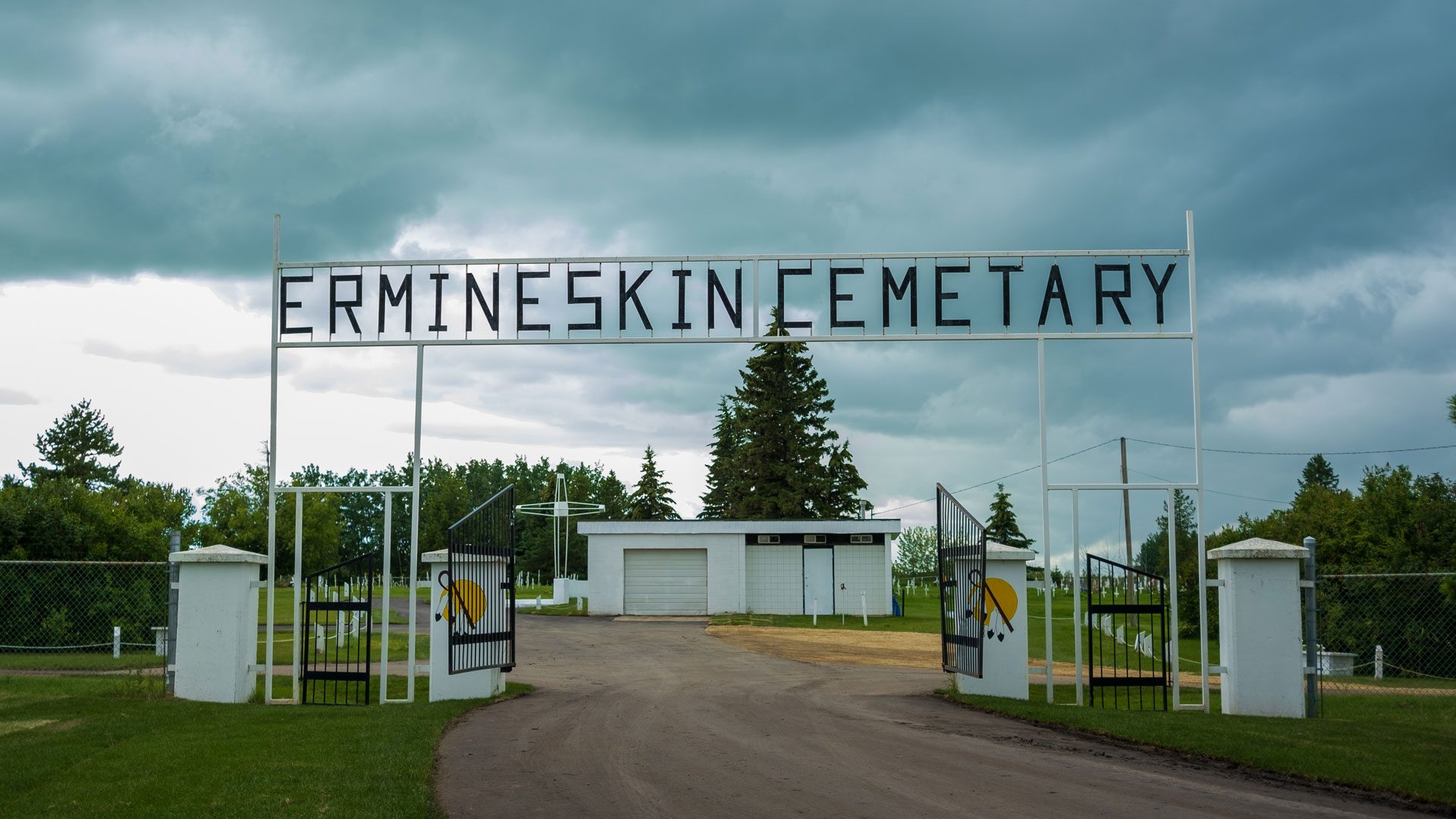
Pope Francis stops to pray in the Ermineskin Cemetery, where hundreds of graves reside. But families here know there’s also many unmarked graves of children – who attended the institution close by.
The former Ermineskin Indian Residential School was located across from this cemetery. Now demolished, where five tipis stand.
Maskwacis chiefs and the Pope pause for a somber moment here before making their way to Muskwa Park arbor.
The scent of smudge and the sound of drums and jingle dresses fills the air provided by those whose very culture and language was prohibited in the residential school system.
Survivors carry a large red banner that bears the names of 4,120 children who never came home from the institutions.
“Your Holiness, you have said that you have come as a pilgrim, seeking to walk together with us on the pathway of truth, justice, healing, reconciliation and hope,” Littlechild said in his opening remarks. “In that spirit, we sincerely hope that our encounter this morning and the words you share with us, will echo the true healing and real hope throughout many generations to come.”
The Papal apology

The crowd quiets as Pope Francis’s speech is translated from Spanish to English.
“In the face of this deplorable evil, the Church kneels before God and implores His forgiveness for the sins of her children. I myself, wish to reaffirm this with shame and unambiguously I humbly beg forgiveness for the evil committed by so many Christians against the Indigenous peoples,” the Pope said.
Many in the crowd cheer at the words, while others keep solemn expression and remain silent. Still others burst into tears.
It’s an historic moment that is difficult to describe, with words many survivors and their families have waited lifetimes to hear.
A day filled with deep emotion and gestures of reconciliation as Dr. Littlechild places a traditional war bonnet on the head of the Pope Francis.
And a time of fierce resilience as Cree singer Si Pih Ko captivates the crowd with her powerful rendition of Oh Canada in Cree.
Lac Ste. Anne

It’s known as Manito Sahkahigan or spirit lake by the plains Cree, a spiritual centre long believed to be a place of healing throughout the region.
For generations, believers from all faiths have made the annual pilgrimage to the sacred waters of Lac Ste. Anne.
Country gospel music rings out as pilgrims set up their lawn chairs under the hot afternoon sun.
It’s a time for faith and fellowship, made even more meaningful with Pope Francis’ historic apology.
“It was very emotional, I had mixed feelings prior before he came. Was I ready for an apology? Was I ready to forgive? Flora Northwest said. “It’s been many years since I was a victim of the residential schools. You know, I was not a person, I was a number. And for many years I had very low self-esteem.”
Northwest was born and raised in Maskwaci. She’s a respected Elder and knowledge keeper who spent more than 10 years at the Ermineskin Residential School.
She’s come to Lac Ste. Anne to see the Pope once more and to connect with other Survivors.
“What the government’s intent was to kill the Indian in me,” Northwest said sitting down and placing her hands on her ribbon skirt. “Well, I’m proud to say that they didn’t kill this Indian. I still have my language, I came back to my traditions, I came back to my culture and I’m very proud of who I am today.”
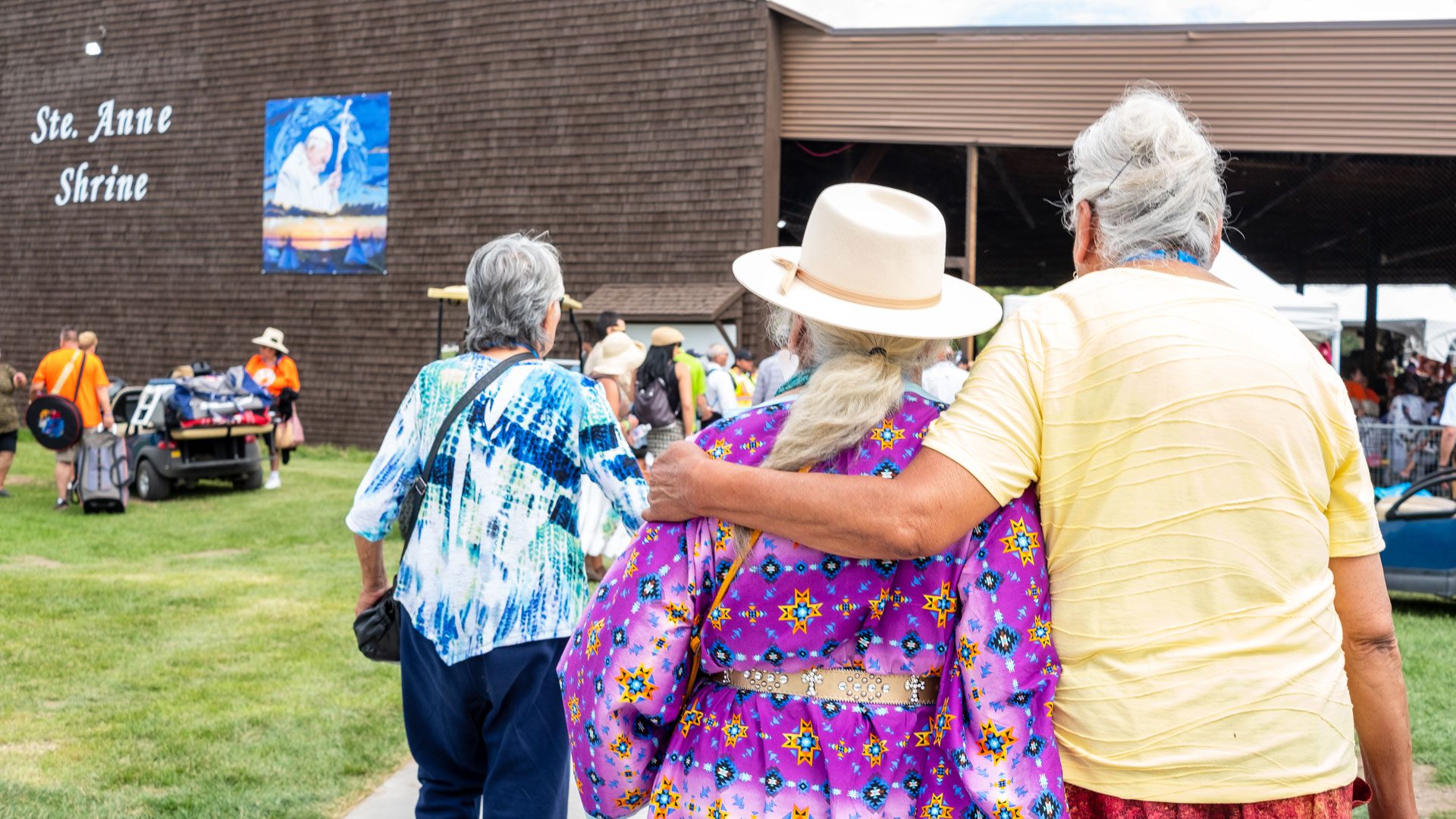
While the Pope’s visit has been praised as an important first step towards reconciliation by some, the apology itself has already become a contentious and sensitive issue.
And what happens next remains equally important.
“If every Canadian could just listen to us, it would be great. But we still face racism, we still have colonizers, you know we still have problems, but it’s up to us to take care of those problems. It’s up to us to move forward, and for me, I am ready to move forward, for me it’s exciting that I was able to forgive,” she said.
Pope Francis sits, head bowed by the shore of the lake under a wooden pavilion with a white steeple.
Behind him, thousands of pilgrims gather to hear his prayer as they each make their own way in their healing journey.
“This is very historic for us because it tells the history of the abuse our people went through in these residential schools,” said Kathleen McHugh who has travelled with Siksika Nation Disability Services. “We’ve waited all our lives to hear some type of apology. The real perpetrators did not apologize, but the church is apologizing on their behalf, so that means a lot to us.”
But even with the apology, there are still many unanswered questions about how to move forward.
Canada’s colonial legacy, both at the hands of the church and the federal government are still painfully present.
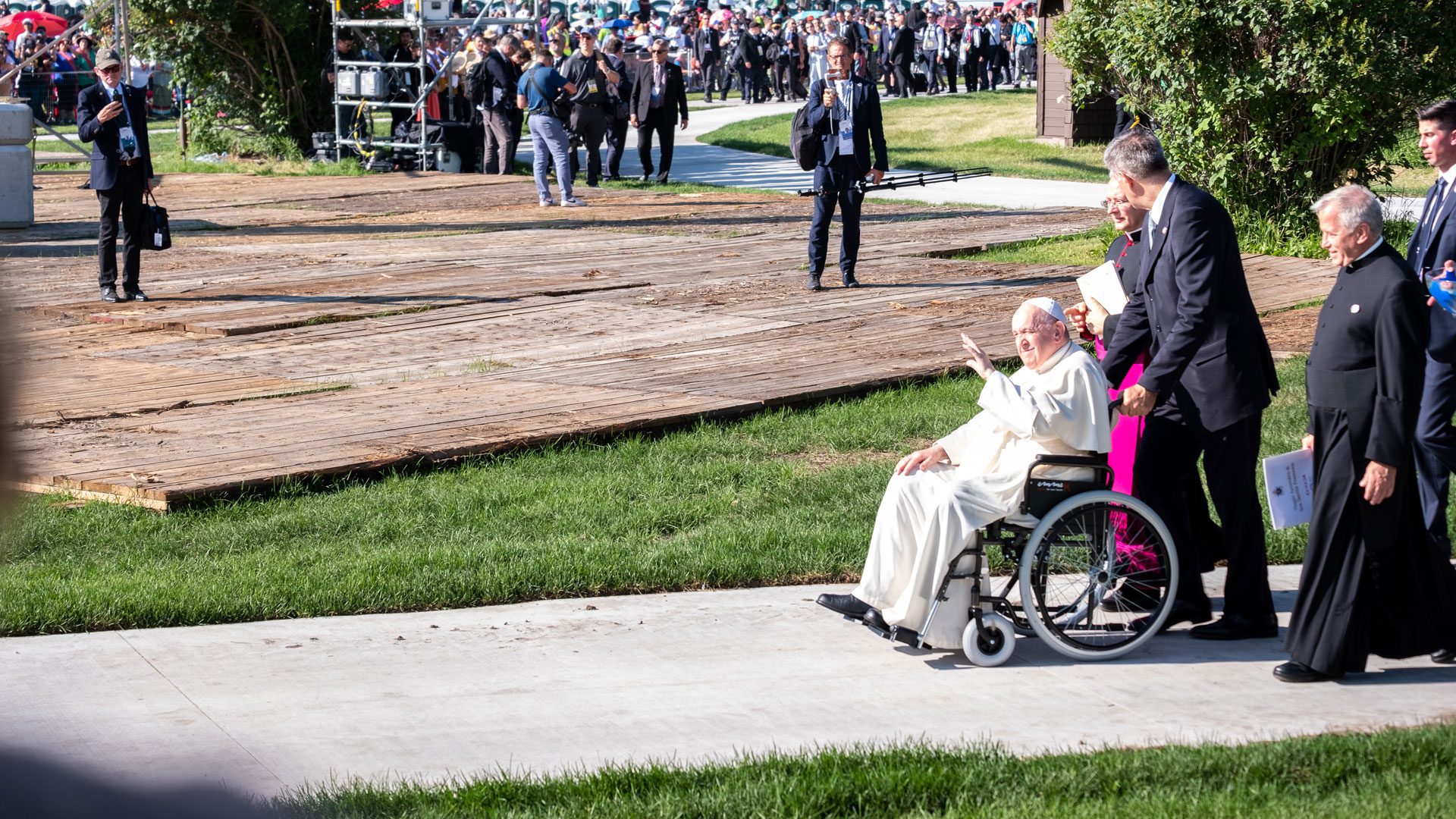
The visit has only amplified the question of what role the church and state still has left to play with unmarked graves, outstanding payments for survivors calls for the release of school records and artifacts stored in the Vatican, investigations into the misconduct of the church and perpetrators and more.
Jodi Calahoo Stonehouse comes to Lac Ste. Anne annually, but this year with her mother and her daughter present she’s reflecting even more on how to move forward.
“When we get to the deconstruction of the doctrine of discovery and the removal of the papal bulls, this is the start, this is the relationship and it’s going to take time, Stonehouse said. “We didn’t get here over night, it took hundreds of years to get to this place and we’re opening a wound that has deep sorrow and pain.”
Many Indigenous communities had been hoping that the Pope would rescind the centuries-old colonial policies including the Doctrine of Discovery.
This papal bull granted a blessing for the Roman Catholic Churches to evangelically acquire property while dispossessing Indigenous people of their land.
Pope Francis vaguely acknowledged a reckoning within the church is required.
“Dear brothers and sisters, many of you and your representatives have stated that begging pardon is not the end of the matter. I fully agree that is only the first step, the starting point,” Pope Francis said.
The crowd moves into the shrine for evening prayers where the Pope is once again given gifts by Indigenous leaders.

A Métis sash is draped around him as onlookers loudly cheer.
While powerful messages are exchanged, survivors like Leo Bruno, remain cautiously optimistic but know true reconciliation requires action from the church.
“I’ve never had an I’m sorry, from an oblate, from a nun, from a teacher,” he said. “When the Pope came to make his apology, that’s just the beginning and there’s a lot more work that needs to be done. And a lot more action behind what’s been said and done thus far.”
Post apology
Back on Maskwacis, the communities have returned to some sense of normalcy.
Stepping out from his log home Bruno shuffles down the long gravel driveway to collect buffalo and prairie sage for smudging and to reflect on all that has happened in the last 72 hours.
“In my language, I thank our Creator for giving us the opportunity, our grandfather’s son, according to our Elders that in our way we are grateful and thankful that we are here today.”
Read More:
Road to Truth: The Pope’s Apology
Editor’s Note: The direct translation for ᑳᓯᓇᒪᑫᐃᐧᐣ is: forgive me







